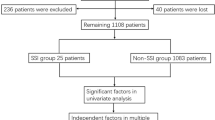Abstract
Purpose
The purpose of this study is to investigate and compare the surgical site infection (SSI) rates of children and adults after open tibia fracture at a single medical centre.
Methods
A retrospective study was performed on patients who sustained open tibia fractures and who received treatment at our hospital from 2012 to 2016. Data on age, gender, fracture site, Gustilo-Anderson grade, treatment management, and culture results from the infection site were recorded.
Results
Overall, 37 children with a mean age of 7.19 ± 2.28 years and 89 adults with a mean age of 40.38 ± 13.53 years were enrolled. The rate of SSIs was 13.5% (6/37) in children, which was significantly lower than the 21.3% (19/89) rate in adults (p < 0.001). The mean number of days to discharge was 12.86 ± 10.25 in children, which was significantly lower than the mean of 28.67 ± 16.92 days in adults (p < 0.001). Furthermore, the average waiting time for soft tissue recovery before definitive surgery was 1.41 ± 1.79 and 8.42 ± 4.38 days in children and in adults, respectively, and the difference was significant (p < 0.001). Early infection occurred more frequently in adults (5/19) than in children (0/6). Staphylococcus aureus was the most commonly found pathogen in both groups.
Conclusion
The SSI rate of paediatric patients after open tibia fracture fixation is significantly lower than that of adults, and the prognosis of the former is superior. The results indicate a superior ability of soft tissue recovery and infection resistance after open tibia fracture fixation among children.


Similar content being viewed by others
References
Simon AK, Hollander GA, McMichael A (2015) Evolution of the immune system in humans from infancy to old age. Proc Biol Sci 282(1821):20143085. https://doi.org/10.1098/rspb.2014.3085
Nandra RS, Wu F, Gaffey A, Bache CE (2017) The management of open tibial fractures in children: a retrospective case series of eight years’ experience of 61 cases at a paediatric specialist centre. Bone Joint J 99-B(4):544–553. https://doi.org/10.1302/0301-620X.99B4.37855
Acute Respiratory Distress Syndrome N, Brower RG, Matthay MA, Morris A, Schoenfeld D, Thompson BT, Wheeler A (2000) Ventilation with lower tidal volumes as compared with traditional tidal volumes for acute lung injury and the acute respiratory distress syndrome. N Engl J Med 342(18):1301–1308. https://doi.org/10.1056/NEJM200005043421801
Dahlem P, van Aalderen WM, Hamaker ME, Dijkgraaf MG, Bos AP (2003) Incidence and short-term outcome of acute lung injury in mechanically ventilated children. Eur Respir J 22(6):980–985
Flori HR, Glidden DV, Rutherford GW, Matthay MA (2005) Pediatric acute lung injury: prospective evaluation of risk factors associated with mortality. Am J Respir Crit Care Med 171(9):995–1001. https://doi.org/10.1164/rccm.200404-544OC
Wood JH, Partrick DA, Johnston RB Jr (2010) The inflammatory response to injury in children. Curr Opin Pediatr 22(3):315–320. https://doi.org/10.1097/MOP.0b013e328338da48
Zimmerman JJ, Akhtar SR, Caldwell E, Rubenfeld GD (2009) Incidence and outcomes of pediatric acute lung injury. Pediatrics 124(1):87–95. https://doi.org/10.1542/peds.2007-2462
Sebastian MR, Lodha R, Kabra SK (2009) Chikungunya infection in children. Indian J Pediatr 76(2):185–189. https://doi.org/10.1007/s12098-009-0049-6
Simarmata D, Ng DC, Kam YW, Lee B, Sum MS, Her Z, Chow A, Leo YS, Cardosa J, Perera D, Ooi MH, Ng LF (2016) Early clearance of Chikungunya virus in children is associated with a strong innate immune response. Sci Rep 6:26097. https://doi.org/10.1038/srep26097
Zingarelli B, Hake PW, O'Connor M, Burroughs TJ, Wong HR, Solomkin JS, Lentsch AB (2009) Lung injury after hemorrhage is age dependent: role of peroxisome proliferator-activated receptor gamma. Crit Care Med 37(6):1978–1987. https://doi.org/10.1097/CCM.0b013e31819feb4d
Mangram AJ, Horan TC, Pearson ML, Silver LC, Jarvis WR (1999) Guideline for Prevention of Surgical Site Infection, 1999. Centers for Disease Control and Prevention (CDC) Hospital Infection Control Practices Advisory Committee. Am J Infect Control 27(2):97–132
Metsemakers WJ, Kuehl R, Moriarty TF, Richards RG, Verhofstad MH, Borens O, Kates S, Morgenstern M (2016) Infection after fracture fixation: current surgical and microbiological concepts. Injury. https://doi.org/10.1016/j.injury.2016.09.019
Razavi A, Bagheri N, Azadegan-Dehkordi F, Shirzad M, Rahimian G, Rafieian-Kopaei M, Shirzad H (2015) Comparative immune response in children and adults with H. pylori infection. J Immunol Res 2015:315957. https://doi.org/10.1155/2015/315957
Chen W, Lv H, Liu S, Liu B, Zhu Y, Chen X, Yang G, Liu L, Zhang T, Wang H, Yin B, Guo J, Zhang X, Li Y, Smith D, Hu P, Sun J, Zhang Y (2017) National incidence of traumatic fractures in China: a retrospective survey of 512 187 individuals. Lancet Glob Health 5(8):e807–e817. https://doi.org/10.1016/S2214-109X(17)30222-X
Mayranpaa MK, Makitie O, Kallio PE (2010) Decreasing incidence and changing pattern of childhood fractures: a population-based study. J Bone Miner Res 25(12):2752–2759. https://doi.org/10.1002/jbmr.155
Vallamshetla VR, De Silva U, Bache CE, Gibbons PJ (2006) Flexible intramedullary nails for unstable fractures of the tibia in children. An eight-year experience. J Bone Joint Surg Br 88(4):536–540. https://doi.org/10.1302/0301-620X.88B4.17363
Srivastava AK, Mehlman CT, Wall EJ, Do TT (2008) Elastic stable intramedullary nailing of tibial shaft fractures in children. J Pediatr Orthop 28(2):152–158. https://doi.org/10.1097/BPO.0b013e318165210d
Southeast Fracture C (2016) LCP versus LISS in the treatment of open and closed distal femur fractures: does it make a difference? J Orthop Trauma 30(6):e212–e216. https://doi.org/10.1097/BOT.0000000000000507
Momaya AM, Hlavacek J, Etier B, Johannesmeyer D, Oladeji LO, Niemeier TE, Herrera N, Lowe JA (2016) Risk factors for infection after operative fixation of tibial plateau fractures. Injury 47(7):1501–1505. https://doi.org/10.1016/j.injury.2016.04.011
Author information
Authors and Affiliations
Corresponding author
Rights and permissions
About this article
Cite this article
Chen, H., Chen, S., Shi, Y. et al. Children with open tibial fractures show significantly lower infection rates than adults: clinical comparative study. International Orthopaedics (SICOT) 43, 713–718 (2019). https://doi.org/10.1007/s00264-018-3996-6
Received:
Accepted:
Published:
Issue Date:
DOI: https://doi.org/10.1007/s00264-018-3996-6



